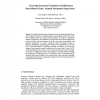Free Online Productivity Tools
i2Speak
i2Symbol
i2OCR
iTex2Img
iWeb2Print
iWeb2Shot
i2Type
iPdf2Split
iPdf2Merge
i2Bopomofo
i2Arabic
i2Style
i2Image
i2PDF
iLatex2Rtf
Sci2ools
84
Voted
BIOSURVEILLANCE
2007
Springer
2007
Springer
Assessing Seasonal Variation in Multisource Surveillance Data: Annual Harmonic Regression
A significant proportion of human diseases, spanning the gamut from viral respiratory disease to arthropod-borne macroparasitic infections of the blood, exhibit distinct and stable seasonal patterns of incidence. Traditional statistical methods for the evaluation of seasonal time-series data emphasize the removal of these seasonal variations to be able to examine non-periodic, and therefore unexpected, or ‘excess’, incidence. Here, the authors present an alternate methodology emphasizing the retention and quantification of exactly these seasonal fluctuations, explicitly examining the changes in severity and timing of the expected seasonal outbreaks over several years. Using a PCRconfirmed Influenza time series as a case study, the authors provide an example of this type of analysis and discuss the potential uses of this method, including the comparison of differing sources of surveillance data. The requirements for statistical and practical validity, and considerations of data coll...
BIOSURVEILLANCE 2007 | Seasonal | Seasonal Time-series Data | Security Privacy | Stable Seasonal Patterns |
| Added | 07 Jun 2010 |
| Updated | 07 Jun 2010 |
| Type | Conference |
| Year | 2007 |
| Where | BIOSURVEILLANCE |
| Authors | Eric Lofgren, Nina Fefferman, Meena Doshi, Elena N. Naumova |
Comments (0)

